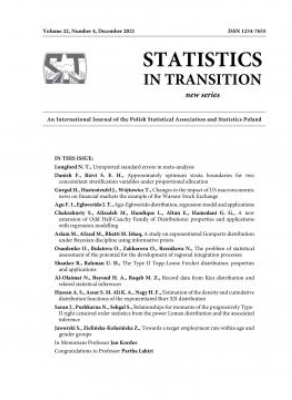A comparative study of a class of direct estimators for domain mean with a direct ratio estimator for domain mean using auxiliary character
A comparative study of a class of direct estimators for domain mean with a direct ratio estimator for domain mean using auxiliary character
Author(s): Brij Behari Khare, Kumar Ashutosh Ashutosh, Piyush Kant RaiSubject(s): Methodology and research technology
Published by: Główny Urząd Statystyczny
Keywords: domain; auxiliary character; direct ratio estimator; class of estimators; mean square error (MSE);
Summary/Abstract: Estimation techniques for a domain parameter play a very significant role in the theory of sample surveys. In the recent years many advanced methodologies have been developed for domain estimation. In particular, direct and synthetic estimators are applied for the estimation of domain mean in the government and private sectors under certain assumptions as to the size of the samples relating to particular domains. The findings demonstrate that the direct estimator fails to perform more efficiently as compared to the synthetic estimator when reliable units are not directly accessible in the studied domains. Moreover, due to the fact that small units belong to the sample of the studied domain, the direct estimator produces an unacceptably large standard error. In contrast, if a sufficient number of units are available in the studied domain, the direct estimator produces effective results. This paper presents the theoretical aspects of the proposed class of direct estimators for domain mean with the use of a single auxiliary character, compared with an existing direct ratio estimator for domain mean (given in section 3.2). In addition, an empirical study has been provided to support the validity of the proposed estimators. The findings prove that the proposed estimators outperform the direct ratio estimator for domain mean using a single auxiliary character in the case of two studied populations and their analysed domains considered from Sarndal et al. (1992).
Journal: Statistics in Transition. New Series
- Issue Year: 22/2021
- Issue No: 2
- Page Range: 189-200
- Page Count: 12
- Language: English

